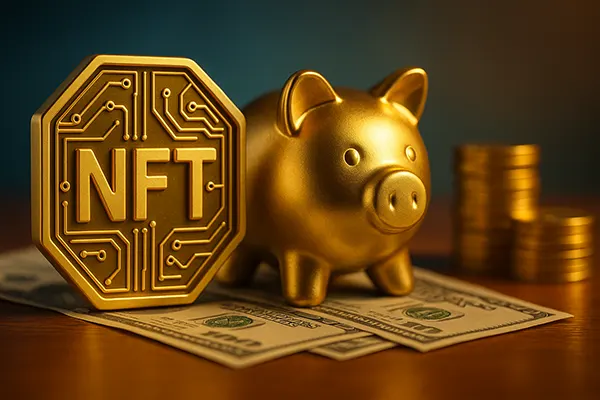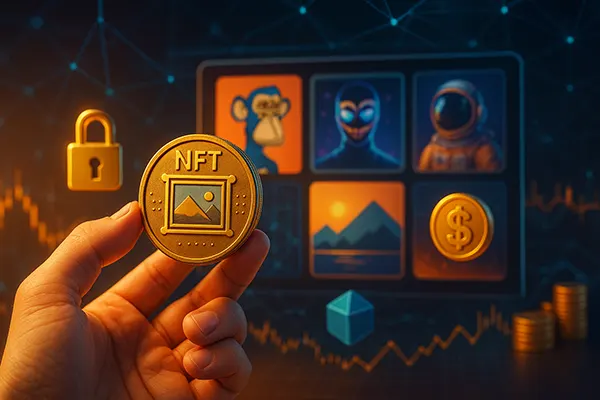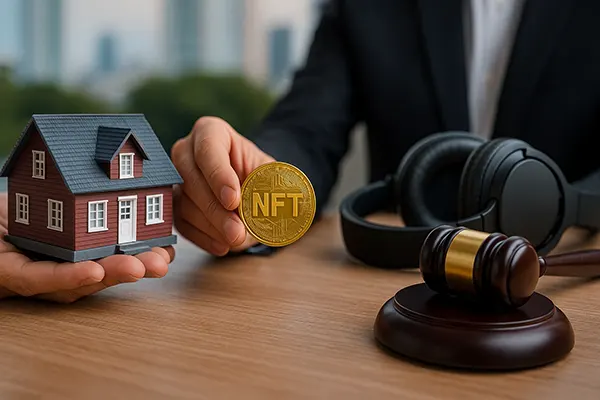
NFT as Loan Collateral: A New Financial Tool or a High-Risk Experiment?
The rapid growth of decentralised finance has led to NFTs becoming more than just digital collectibles. By 2025, tokenised assets are increasingly used as collateral for obtaining crypto loans, creating new financial opportunities but also raising concerns regarding volatility, valuation, and legal clarity. This article examines how this mechanism works, what benefits it offers, and what risks borrowers and lenders face in real-world scenarios.
The Rise of NFT-Backed Lending
Over the past three years, NFT-backed lending has shifted from an experimental model to a functioning sector within decentralised finance. Major lending protocols such as Arcade, NFTfi, Blend, and Paraspace introduced systems that allow users to lock their NFTs and borrow stablecoins or cryptocurrency against them. This model became particularly attractive during market recovery phases, when blue-chip NFTs such as CryptoPunks or Bored Ape Yacht Club regained liquidity and value.
The main driver behind this trend is the need for liquidity without selling long-term assets. NFT holders who expect market appreciation often prefer borrowing instead of disposing of their tokens. At the same time, lenders receive a higher interest rate compared to traditional over-collateralised loans, making the system mutually beneficial when markets are stable.
Despite the progress, NFT-backed lending remains highly dependent on market sentiment. Borrowers must monitor price fluctuations closely, as sudden downturns can lead to automatic liquidations. This sensitivity to volatility is one of the reasons regulators and analysts continue to classify NFT collateral as an emerging, not fully mature financial tool.
How NFT Collateralisation Works in Practice
The process of taking a loan with an NFT is technically simple but economically complex. Users transfer their asset to a smart contract where it is locked until the debt is repaid. The lender then provides the requested amount in stablecoins or cryptocurrency, based on the NFT’s current market value and liquidity profile. Loan terms, interest rate, and repayment deadlines are often fixed directly in the contract.
The valuation process is the most challenging element. Unlike fungible tokens, NFTs are unique, and market prices depend heavily on rarity, community demand, and recent sales of comparable items. By 2025, automated valuation tools improved significantly, but the final assessment still involves uncertainty, especially for mid-tier collections with inconsistent trading volumes.
Once the loan term ends, the borrower repays the principal plus interest. If repayment does not occur on time, the lender gains full ownership of the NFT. This mechanism encourages strict discipline among borrowers but also exposes them to a complete loss of the asset if liquidity suddenly becomes insufficient.
Key Advantages of Using NFTs as Collateral
Using NFTs to secure loans creates access to liquidity that was previously unavailable to owners of digital art, virtual land, or in-game items. In many cases, borrowers can obtain financing while still keeping long-term exposure to their digital assets, which may appreciate in value. This mechanism is comparable to borrowing against traditional luxury goods, but without intermediaries or geographical restrictions.
The decentralised structure of NFT lending reduces dependence on traditional banks. Smart contracts automatically manage repayments, interest rates, and liquidations, minimising human error. For active traders, this provides opportunities to allocate liquidity to other investments, hedge positions, or cover operational costs without selling valuable assets.
Finally, the growing involvement of institutional participants increases the credibility of this sector. By 2025, several regulated custodians began offering NFT storage for collateralised loans, creating more transparent conditions for high-value collections and professional investors. This infrastructure helps attract capital from organisations that previously avoided NFT exposure.
The Role of Blue-Chip Collections
Not all NFTs carry the same level of trust from lenders. Blue-chip collections with high historical trading volumes and strong communities are significantly more accepted as collateral. CryptoPunks, Bored Ape Yacht Club, Azuki, and Art Blocks Curated are among the most commonly used, as they retain liquidity even during market instability.
Lenders prefer assets with predictable price behaviour, and these collections typically have reliable valuation data. This reduces the risk of under-collateralisation and sudden drops in floor price. As a result, borrowers using blue-chip NFTs often receive better terms, including lower interest rates and higher loan-to-value ratios.
The dominance of blue-chip assets also shapes lending platform policies. Many protocols impose stricter criteria for lower-tier NFTs, requiring higher collateral ratios or providing shorter loan terms. This illustrates how deeply the market relies on reputation and proven demand when forming credit conditions.

Main Risks and Market Challenges
Despite its advantages, NFT-backed lending remains one of the most volatile segments of the crypto industry. A sharp decline in floor price can trigger rapid liquidations, causing borrowers to lose their assets and lenders to recover less value than expected. This risk is amplified by the speculative nature of many NFT collections, where prices often react to short-term market events rather than intrinsic utility.
Liquidity issues present another challenge. Even highly popular collections may face periods of reduced trading activity, making them harder to liquidate in time-sensitive situations. Lenders must account for this possibility, often by setting conservative loan-to-value ratios. Borrowers, meanwhile, face uncertainty regarding the market conditions during their loan period.
Legal uncertainty further complicates the landscape. Regulations regarding digital assets continue to evolve, and different jurisdictions interpret NFTs differently — as property, intellectual rights, or entirely new asset categories. This lack of clarity affects institutional adoption and may influence future development of NFT lending platforms.
Future Outlook and Potential Regulation
The future of NFT-backed lending depends largely on regulatory adaptation and improved valuation standards. By 2025, discussions about establishing unified frameworks intensified, especially concerning consumer protection and transparency. Clearer rules could support the entry of more institutional players and enhance borrower protection during liquidation events.
Technological progress will also shape the development of this sector. More accurate AI-driven pricing models and risk analysis tools can reduce uncertainty and help lenders evaluate collateral more reliably. Improved liquidity aggregation solutions may also assist in stabilising liquidation processes during market downturns.
Ultimately, NFT collateralisation is likely to evolve into a specialised area of decentralised finance. While it offers meaningful financial opportunities, the risks associated with market volatility, pricing challenges, and regulatory ambiguity mean it will continue to suit informed users capable of managing these complexities.




